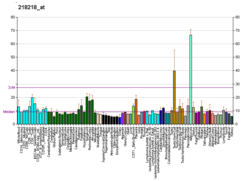| APPL2 |
|---|
|
| Available structures |
|---|
| PDB | Ortholog search: PDBe RCSB |
|---|
| List of PDB id codes |
|---|
4H8S, 5C5B |
|
|
| Identifiers |
|---|
| Aliases | APPL2, DIP13B, adaptor protein, phosphotyrosine interacting with PH domain and leucine zipper 2 |
|---|
| External IDs | OMIM: 606231; MGI: 2384914; HomoloGene: 10046; GeneCards: APPL2; OMA:APPL2 - orthologs |
|---|
| Gene location (Human) |
|---|
 | | Chr. | Chromosome 12 (human)[1] |
|---|
| | Band | 12q23.3 | Start | 105,173,297 bp[1] |
|---|
| End | 105,236,203 bp[1] |
|---|
|
| Gene location (Mouse) |
|---|
 | | Chr. | Chromosome 10 (mouse)[2] |
|---|
| | Band | 10|10 C1 | Start | 83,435,897 bp[2] |
|---|
| End | 83,484,602 bp[2] |
|---|
|
| RNA expression pattern |
|---|
| Bgee | | Human | Mouse (ortholog) |
|---|
| Top expressed in | - skin of leg
- skin of abdomen
- rectum
- mucosa of transverse colon
- ventricular zone
- Achilles tendon
- stromal cell of endometrium
- canal of the cervix
- ectocervix
- bronchial epithelial cell
|
| | Top expressed in | - retinal pigment epithelium
- ciliary body
- iris
- cerebellar cortex
- neural layer of retina
- parotid gland
- lobe of cerebellum
- cerebellar vermis
- lacrimal gland
- epithelium of stomach
|
| | More reference expression data |
|
|---|
| BioGPS |  | | More reference expression data |
|
|---|
|
| Gene ontology |
|---|
| Molecular function | - protein binding
- phosphatidylserine binding
- phosphatidylinositol binding
- protein homodimerization activity
- protein-containing complex binding
| | Cellular component | - cytoplasm
- NuRD complex
- endosome
- early endosome membrane
- endosome membrane
- extracellular exosome
- membrane
- nucleus
- ruffle
- plasma membrane
- cytoplasmic vesicle
- vesicle
- early phagosome
- ruffle membrane
- early phagosome membrane
- macropinosome
- phagocytic vesicle membrane
- cell projection
- phagocytic vesicle
| | Biological process | - cell cycle
- cell population proliferation
- signal transduction
- diet induced thermogenesis
- transforming growth factor beta receptor signaling pathway
- cold acclimation
- regulation of fibroblast migration
- signaling
- adiponectin-activated signaling pathway
- regulation of toll-like receptor 4 signaling pathway
- cellular response to hepatocyte growth factor stimulus
- glucose homeostasis
- regulation of innate immune response
- negative regulation of fatty acid oxidation
- negative regulation of glucose import
- negative regulation of neurogenesis
- protein homotetramerization
- positive regulation of phagocytosis, engulfment
- positive regulation of cold-induced thermogenesis
- negative regulation of cytokine production involved in inflammatory response
- negative regulation of cellular response to insulin stimulus
- positive regulation of macropinocytosis
- positive regulation of Fc-gamma receptor signaling pathway involved in phagocytosis
- negative regulation of neural precursor cell proliferation
- protein import into nucleus
| | Sources:Amigo / QuickGO |
|
| Orthologs |
|---|
| Species | Human | Mouse |
|---|
| Entrez | | |
|---|
| Ensembl | | |
|---|
| UniProt | | |
|---|
| RefSeq (mRNA) | |
|---|
NM_001251904
NM_001251905
NM_018171 |
| |
|---|
| RefSeq (protein) | |
|---|
NP_001238833
NP_001238834
NP_060641 |
| |
|---|
| Location (UCSC) | Chr 12: 105.17 – 105.24 Mb | Chr 10: 83.44 – 83.48 Mb |
|---|
| PubMed search | [3] | [4] |
|---|
|
| Wikidata |
| View/Edit Human | View/Edit Mouse |
|


















